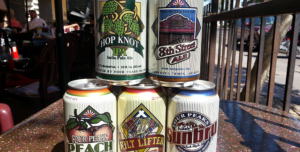I’ve always insisted that bottling beer is a major feat of technology and engineering. That is, if it’s 1908.
Actually, bottling is a fine way to get beer into the hands of those who want to drink it. And, despite my joke, it has advanced technologically over the last century. It just has so many potential flaws and economic drawbacks it’s a wonder that beer bottles haven’t gone the way of the dinosaur in favor of some other method of packaging like, oh, say, cans for instance.
Beer has many enemies, and I’m not talking about prohibitionists. Perhaps the greatest foe in terms of keeping beer fresh is oxygen. Oxygen staling in beer is a complicated chemical pathway. So, let’s just say that a very little oxygen can ruin a great deal of beer.
If you look at a bottle you’ll notice it isn’t filled all the way to the top. What’s in there? Hopefully it’s filled with CO2, but you can’t always get all of the air out. And when there is as much headspace as in a bottle then there’s that much more oxygen.
Sunlight is also a sworn enemy of beer. When sunlight hits beer it actually alters some of the hop compounds which create a distinct musky aroma. To brewers it’s called being light-struck. But to most people it’s called skunky beer. For the most part brown bottles have solved the problem, but if your favorite beer comes in a green or clear bottle you’ve probably noticed it.
Aside from flavor changes and staling, bottles are expensive.
They’re heavy, which means it costs more to ship them from glass-maker to brewer. They also require a cap, a label (sometimes two), a six pack carton, and a case carton. Not only do these things raise the costs of bottled beer, but in terms of the environment there is a lot of extra packaging that has to be disposed of.
Aluminum cans solve most of these problems: there is very little headspace in a can, they’re impervious to sunlight, they’re lightweight, made of recyclable material, don’t require labels, and, oh yeah, they don’t break. This means they’re welcome at campgrounds, golf courses and fishing trips.
So, why aren’t bottles extinct? One word: stigma.
It reminds me of the screw-top vs. cork controversy that the winemakers are mixed up in. It’s proven that screw-tops keep certain wines fresher, longer. But screw-tops are often equated with inexpensive or inferior wine. And it’s true on the beer side too; despite all of the positives when it comes to using cans people still think it is somehow a cheap product or that it “tastes like the can.”
However, thanks to many pioneering craft brewers around the country, and even several here in Arizona, that stigma is changing. Big, flavorful beer does belong in a can and people are starting to realize that just because it is packaged the same as some mega-brew you’d find at a convenience store it sure doesn’t taste that way. And as far as tasting like the can, it’s not true.
The patented (and secret) process for lining modern cans makes it virtually impossible to extract any flavor from the aluminum.
Share:Original Source Here

